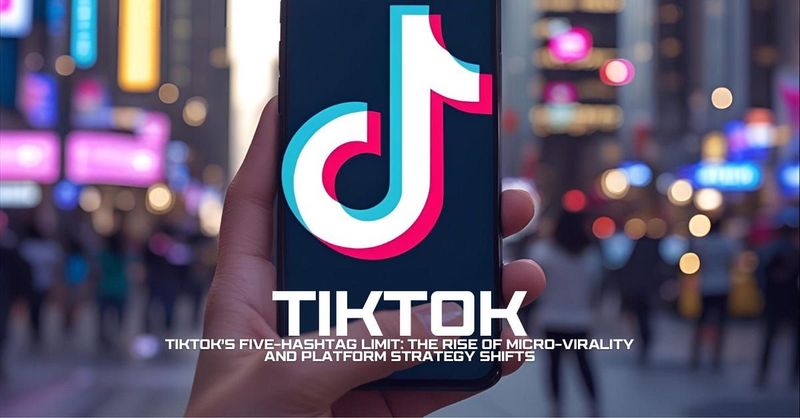TikTok’s Five Hashtag Limit The Rise of Micro Virality and Platform Strategy Shifts
Hey there, fellow scrollers and content junkies! Have you ever felt that rush when your TikTok video suddenly blows up, all thanks to a clever string of hashtags? Well, buckle up because TikTok just flipped the script on us.
In the summer of 2025, they rolled out a bombshell update: no more than five hashtags per post. Yeah, you read that right—five. It’s like they took our trusty toolkit and shrunk it down to pocket size. But why the fuss?
This change isn’t just a minor tweak; it’s sparking heated debates across the creator community, reshaping how we chase those elusive views, and hinting at bigger shifts in how platforms like TikTok operate. Let’s dive in, shall we? We’ll unpack the controversy, explore what it means for your strategy, and maybe even find some silver linings in this hashtag apocalypse.
Imagine you’re a budding creator, pouring your heart into a dance routine or a hilarious skit, only to hit “post” and get slapped with a warning: “Limit reached—only five hashtags allowed.” Frustrating, right?
This rule, quietly introduced around July 2025, aims to clean up captions and make discovery more meaningful, but it’s left many feeling handcuffed. From small-time editors to business owners using TikTok for ads, the backlash is real and raw. And yet, amid the chaos, something intriguing is emerging: micro-virality. It’s that laser-focused buzz where content spreads not through blanket tagging but through hyper-relevant connections.
Think of it like switching from shouting in a crowded stadium to whispering secrets in a cozy club—fewer people hear, but those who do really listen.
But hold on, is this the end of easy virality or the start of something smarter? As we chat through this, I’ll share stories, tips, and insights to help you navigate it all. After all, TikTok’s algorithm is like a finicky cat—pet it wrong, and it scratches; get it right, and it purrs with views.
TikTok’s Hashtag Revolution
Picture this: You’re crafting the perfect caption, layering on hashtags like toppings on a sundae—#DanceChallenge, #ViralVibes, #FunnyMoments, and a dozen more. Boom, visibility skyrockets. That was the old TikTok. Now, with the five-hashtag cap, it’s like the platform said, “Enough with the excess; let’s get precise.” This isn’t just about limiting words; it’s a fundamental rethink of how content gets discovered.
What Exactly Happened with the Five-Hashtag Rule?
It all started subtly. Users began noticing pop-up notifications in July 2025, warning them against adding a sixth hashtag.  By August, it was official: TikTok capped it at five to “enhance user experience and maintain a clean feed.”  No grand announcement, just a quiet rollout that caught creators off guard. Some got hit earlier in A/B testing, while others woke up to it overnight.
Why five? It’s arbitrary yet intentional, forcing us to pick winners instead of spamming losers. But oh boy, did it ignite a firestorm. Creators on Reddit and X (formerly Twitter) vented about plummeting views, with one user lamenting, “My edits used to thrive on 15 tags; now they’re ghosts.” 
Think about it rhetorically: If hashtags are the GPS for your content, what happens when TikTok shrinks the map? You get lost less, but you also miss out on detours that could lead to treasure. This rule ties into TikTok’s broader push for quality over quantity, echoing changes on other platforms. But for many, it’s like being told to run a marathon with one shoe—possible, but painfully awkward.
Why This Change Feels Like a Seismic Shift
Hashtags aren’t just flair; they’re lifelines. They categorize content, boost discoverability, and build communities. Pre-limit, creators could cast a wide net, snagging views from unrelated but popular tags. Now, it’s precision surgery. This shift amplifies micro-virality, where virality happens in niches rather than globally. It’s like evolving from broadcast TV to personalized streaming—more targeted, but potentially less explosive.
The controversy? It’s bubbling because visibility equals income for many. Small creators fear being overshadowed, while big ones adapt seamlessly. Platform-wise, TikTok’s strategy is pivoting toward cleaner interfaces and algorithm-driven discovery, reducing reliance on user tricks. But is it fair? That’s the million-view question we’ll explore next.
The Spark of Controversy: Creators vs. the Algorithm
Oh, the drama! If social media were a soap opera, this hashtag limit would be the plot twist everyone hates. Creators are up in arms, claiming it’s a death knell for growth, while TikTok insists it’s for the greater good. Let’s peel back the layers of this heated debate.
Outrage from Small Creators and Businesses
Small accounts are screaming the loudest. “Us small editors will never grow,” one X user posted, echoing a sentiment shared across forums.  Why?
Hashtags were their secret weapon for punching above their weight, reaching audiences beyond followers. Now, with only five, it’s like fighting with one hand tied. Businesses feel the pinch too—think local shops tagging #CityName, #ServiceType, #Brand, and more to attract customers. One Reddit user worried about lawsuits if income drops, highlighting how this affects real livelihoods. 
Rhetorically, isn’t TikTok built on democratizing fame? This limit feels like pulling up the ladder after the big shots climbed it. Engagement drops reported by users—videos flopping hard—add fuel to the fire.  It’s not just whining; data from early adopters shows views halved for some.
Real Stories of Frustration on Social Media
Dive into X threads, and it’s a venting fest. “TikTok limiting hashtags to 5 has killed my engagement completely,” one artist shared.  Another: “What a joke, lmfao.”  Reddit’s r/Tiktokhelp is flooded with posts like “The 5 hashtag limit is stupid,” where creators mourn lost views and brainstorm workarounds.  Even niche folks, like K-pop fans or mural painters, lament how it stifles specific tagging.
โฆษณา
- ดาวน์โหลดแอปพลิเคชัน
- © 2025 Blockdit



